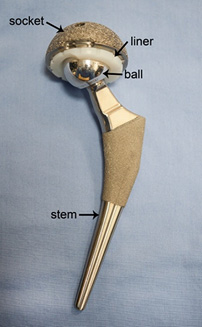Hip replacement, in which the hip joint is removed and replaced with an artificial joint, is a well-known orthopedic procedure. The traditional procedure makes an incision about eight to ten inches in length in order to expose the hip joint. This procedure is considered very safe and effective.

Total hip implant demonstrating socket, liner, ball and stem.
Less invasive hip replacement accomplishes the same goal—removing the damaged hip joint and replacing it with an artificial hip joint—but uses smaller incisions of three to five inches and disturbs less muscle tissue. In addition, less invasive procedures are commonly combined with regional anesthesia (not general anesthesia), improved pain management, and accelerated rehabilitation protocols to facilitate rapid recovery.
What is the Difference Between Hip Replacement and Less Invasive Hip Replacement?
The two procedures have much in common, in that they are performed to replace a damaged hip joint with an artificial prosthesis. Both procedures rely on the same prosthesis—there are no differences in the implant. The main distinction is in the surgical approach. Less invasive hip replacement allows the surgeon to access, remove, and replace the hip joint through smaller incisions.
Why Would Less Invasive Hip Replacement be Performed?
Less invasive hip replacement would be performed for the same reasons that a traditional hip replacement procedure might be performed, that is, to replace a damaged, arthritic hip joint. If you are considering hip replacement, we can discuss whether or not a less invasive or traditional approach would be better for your individual case. Most patients in our practice are treated with a less invasive approach.
The Procedure
Less invasive hip replacement is performed under spinal anesthesia and relies on specially designed surgical instruments to access the hip joint through a small incision. Where the incisions are made depends on the patient’s size, the nature of the procedure, and the surgeon’s preference. Dr. Clohisy performs less invasive hip replacement through both the anterior (front) and posterior (back) approaches. The approach is chosen according to patient-specific factors.
What Can I Expect from Less Invasive Hip Replacement?
Less invasive hip replacement is usually performed under spinal anesthesia and requires a short hospital stay (one to two days). Following the surgery, patients can expect some postsurgical discomfort and a period of rehabilitation. Postsurgical discomfort can be controlled by medication; please discuss your pain level after surgery with your healthcare team. Most patients who undergo less invasive hip replacement experience tolerable levels of discomfort and are able to recover rapidly.
What Can I Expect from Recovery from Less Invasive Hip Replacement?
Following surgery, you will be brought to a recovery room for a few hours and then to your regular hospital room. You will meet with a physical therapist on the day of surgery. As with any hip replacement, you will begin a rehabilitation program in the hospital that will continue for weeks after you are discharged. The physical therapist will teach you the exercises you must do to strengthen your new hip and map out a rehabilitation program. Activities that you must avoid or limit will be reviewed.
In general, patients who are diligent about their rehabilitation exercises have more successful outcomes. If you have questions or concerns during your recovery, please contact us.
What are the Advantages of Less Invasive Hip Replacement Over Other Treatments?
Most people considering hip replacement surgery are evaluated for a less invasive type of procedure. In this evaluation, many factors are considered, including the nature of the hip problem and your overall health. Not all patients are candidates for less invasive hip replacement, especially those with a complex hip deformity or obesity.
The goals of less invasive hip replacement include:
- Less pain
- Fast recovery
- Less blood loss
- Shorter hospital stay
Who is a Candidate for Less Invasive Hip Replacement?
If you require hip replacement, we will advise you as to the appropriate treatment options for your individual case. Most patients are candidates for less invasive hip replacement. The ideal patient is thin and healthy, without a complex hip deformity.
What Are the Risks and Benefits of Less Invasive Hip Replacement?
Although hip replacement is considered a very safe surgery, there are risks with any surgical intervention. In hip replacement surgery, these risks include, but are not limited to bleeding, infection, blood clots, fracture, nerve palsy, leg length inequality, pulmonary embolism, implant loosening, dislocation of the prosthesis, heart attack and stroke. You should speak to Dr. Clohisy about these potential risks and any other concerns you have regarding your surgery.
A hip prosthesis can be expected to last for 20 years, but they can wear out and require replacement. Following surgery, patients may have limitations or restrictions in terms of movement or activity. Most patients who undergo hip replacement surgery of any kind report satisfaction with the procedure, reduced pain, and improved mobility.
How Can I Find Out More?
If you are considering hip replacement surgery, Dr. Clohisy can advise you as to the most appropriate treatment options for your case. Every patient is unique, and we can advise you regarding the most suitable treatment options for your condition.